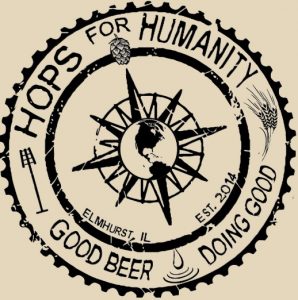They say that in public speaking, when talking about an unfamiliar topic to a diverse group, it is good to begin with a joke. Here is one that you may not have heard before:
“A humanist, transhumanist and a humanitist walk into a bar. The barman says: ‘What would you like to drink?’.
The humanist says: ‘Yes, that is precisely the question – What would I like to drink? – for I can choose any beverage to my liking and I can make it so.’
The transhumanist says: ‘Yes, that is precisely the question – What would I like to drink? – as with each augmentation no object for consumption is beyond my imagination.’
The humanitist says: ‘Yes, that is precisely the question – What would I like to drink? – for I am here to nourish the soul of humankind, and by that action all three of us will be replenished, now and for all known times.’
The humanist and the transhumanist turn to the barman and say, at exactly the same time: “We are in agreement – She’s buying!”
Of course, the joke is really only funny if you know the attributions of the characters, and their differences. However, the joke does reflect the theme of this article of how the humour of our present humanity-level situation may have recently escaped us. This is mostly because we may not be as familiar with ourselves as we’d like to be.
Background Trialogue
The source for this exploration into ‘humanitism’ was that I found myself one night in a bar in San Jose, USA precisely in this situation.
I had caught up with a very clever friend for Bastille Day when visiting town for a conference. We had not seen each other for many years. In a reflection on getting old, he mentioned how he was looking forward to his techno-enhancements, new bio-cybernetic extensions, or even just his brain being freezed and his 25th century re-awakening. Following our playful conversation on the virtues (and vices) of transhumanism, he thought it interesting to introduce me (ie the humanitist) to his colleague who was a card-carrying humanist. Drinks were organised.
As in the classical three person joke, the humour comes from the generative tensions of the triple-biased ‘trialogue’. When done in good humour this assumes an equality of status – with three tensions of directions, and some overlapping connections. I learned a couple of things from our conversation.
The first was that there are two types of transhumanists, those who like living as humans and want to augment this, and those who haven’t enjoyed the experience so far and want to transcend us. The second was that there are two types of humanists, being those who rejoice in the fumbling beauty of human expressions as a life experienced towards perfection, and those reacting to the voice of imposition on their individualism by the pre-destinations of a higher authority. This made me consider that there are perhaps two types of humanitists, being those who hold in them the moment by moment care for a humanity, and those who seek to escape human suffering by expanding the questions we are asking to a place beyond us personally.
To explore these rhetorical (not actual) distinctions further, and the place of their intersection, it is worth going backwards – to introduce the fictional characters in our speculative trialogue. While definitions may not help us in such expansive and changing fields, they may help to locate some distinctivenesses (and synergies) potentially held within all of us.
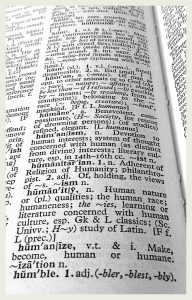
Humanistic Humanism
The history of humanism as a movement possibly obscures its present form. This term as used to describe an existing philosophy is attributed to theologian Friedrich Niethammer (1766-1848) . It’s formal definitions emphasise an affirmation of human dignity, ability and responsibility and the necessity for humanity to select its own destiny (by human agency). It specifies a human place in a natural, rather than supranatural, world while respecting all human beliefs, religions and assumptions that come from the human imagination. A useful resource is: (link)

Transcendent Transhumanism
The origin of transhumanism possibly comes from an early essay by (humanist) Julian Huxley (1887-1975) titled ‘Transhumanism’ in New Bottles for New Wine (1957) pp.13-17. Its formal definition describes a movement that advocates for the transformation of the human condition by developing and making available sophisticated technologies to enhance the human intellect and physiology. In some ways tools, technology and techniques have always done this for mankind, but it is its specific application to the person and the augmentation (or replacement) of the human function that is a source of philosophical and ethical discussion. A useful resource is: (link)
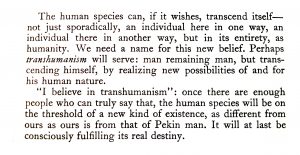
Source: Huxley, J. (1957) p. 17
Holding Humanitism
An unfamiliarity with the word ‘humanitism’ and ‘humanitist’ is to be forgiven. This is because most formal dictionaries do not contain a definition. The idea that we are a member of humanity though, may be taken as a given. Yet the idea that we may think, feel, and experience as a humanity is apparently not definable. While this idea of ‘humanity as an entity’ may not fit within most individual conceptions, because we all are human, it is not outside of any human’s imagination.

There are one or two uses of ‘humanitist’ to distinguish an academic in the literary social sciences who does not want to be considered a ‘scientist’ or a technologist (perhaps a ‘humanities-purist’). However, being a ‘non-scientific humanist’ does not necessarily mean one becomes a humanitist.
We often search for a new term to describe an idea in formation, or an idea that is simply new to ourselves, for which we have no existing word readily available.
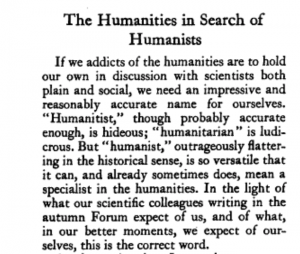
Source: Nesbitt, G. (1947) p. 97
Definition, Distinction and Origins
However, if we look deeper beyond surface definitions the idea of ‘humanitism’ is not without usage and the concept is not without conception.
There is a reference to ‘humanitism’ as a possible translation for the philosophy of the main character in Quincas Borba (1891) of ‘humanitismo‘ in the ironic fiction of Portuguese writer Joaquim Maria Machado de Assis (1839-1908) . Also, the Czech political philosopher (and later President), Tomas Masaryk (1850-1937) used the term ‘humanitista‘ (Van den Belt, 1975) to explicitly distinguish traditional nationalistic humanism ideals from the questions asked by trans-national goals (Nase Doba,1891). This legacy is reflected in Václav Havel‘s (1936-2011) extension of the morality of personal responsibility when requiring us ‘… to transcend the horizon of our own personal interests’ and to be ‘responsible for the whole world’ in the universality of human rights (Letní Přemítání, Havel, V. 1991).
However, the most extensive usage and definition of the English term is sourced to William Allan MacDonald and his treatise: ‘Humanitism: The scientific solution of the social problem‘ (1890) (350 pages).
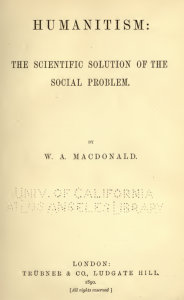
In this expose MacDonald proposes a naturalistic alternative to (the then) contemporary society in its totality. In the style of Aldous Huxley’s ‘Ends and Means: An inquiry into the nature of ideals‘ (1937), he covers topics as diverse as education, religion, ownership, slavery, cultivation, vegetarianism, sexism, nationalism, patriotism, democracy and altruism. The idea of humanitism, as the valuing of a humanity as a principle which gives guidance to human concerns, is clearly apparent. Here is a philosophy that sees humans, not only as they are, but also how we might collectively become in ‘… a condition of ever-increasing health and strength, moral, intellectual and physical, as well as ever increasing virtue and happiness.’ (p. xvi)
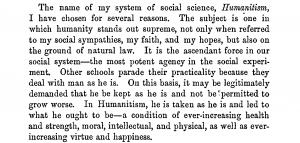
Source: MacDonald (1890) p. xvi
While this 19th century call to reformative action echoes the themes and dichotomies of our modern society, this originating proposal suggests the need for a more contemporary analysis. One review at the time of publication noted the personal (and political) undesirability of MacDonald’s non-utopia, while also acknowledging that ‘our devouring economic activity in heedless selfishness’ effectively operates as a theft on future generations (Belot, G. 1890). MacDonald’s loyalties are not to our perfection since creation, but to a becoming from within humanity’s future destination (ie ‘Mellos‘).
The question that MacDonald’s ‘humanitist’ treatise asks is now even more acute in light of the progression in the expansion of the human population (from 1.6 billion in 1890), a climate-induced humanitarian crisis of habitation, and the given prospect of a generalised artificial intelligence; all asking for the ‘means to the ends’ of our moral self-governance.
The time might be right to consider who a (contemporary) ‘humanity’ is – its wants, and its destiny.
New Century Conceptions
The most interesting aspect of the idea of humanitism is when we see the word written, we think it must mean something different. It is a awkward word, but its concept is so simple.
A humanitist is someone who holds the idea of the preciousness of a humanity, and its continuation, well-being and well-becoming, as being a worthwhile and universal principle for all humans to hold in their role as humanity members.
This humanity-centric aesthetic (and ethic) makes worthy of consideration all those things that make up a human world and its valuings, collectively. This includes the human experience of the natural world, the feeling of us to each other, and all that can be discovered by human design and extension (ie by microscopes to inter-stellar satellites) or by our spiritual speculation (ie all beliefs and religions).
This view does not diminish other sentient’s experiences, but simply recognises that our appreciation and delineation of them is limited to human conceptions, formed in human language, through the human experience, perceived collectively. There is an awe and humility in this holding of a ‘humanity perception’, which is altering and changing through its daily (clumsy and expanding) human-form enactions.
Human Concerns for Humanity
We may all like to think that we are humane, humanistic and humanitarian. However novel research in asking the question astutely, shows that there is no single unity for our conception of humanity (McFarland, Webb, Brown. 2012). Our own concept of humanity is likened to those who we imagine are most like ourselves as a human. There are limitations, distinctions and divisions to a humanity, that are consistent with the boundaries of our personal conceptualisations.
What we find with deeper reflection is how caught out we are by the absence of ‘humanity care’ in our daily reflections. Once we understand the idea of ‘humanitism’, we wonder why not all of us are ‘humanitists’, at least on a good day – when we can care about more than our own comfort, gratification, satisfaction and self-assurances.
Yet in contemporary language, there is not even a formal definition for this conception – of the holding of humanity care, concurrently with our own human concerns. Surely, this is not a state purely reserved for the statistically insignificant Maslowian ‘self-actualiser’ – for is not every member of humanity, already intimately concerned with humanity’s destiny?
Looking further into definitions, we find that an ‘ism’ is ‘a distinctive doctrine, discipline or theory’ that provides a discriminating distinction. In the recent trend where an innocent delineation can equate to a discrimination, we find ‘isms’ not being as valued in defining our stances of preference. Useful terms then fail us when their exclusions are relinquished, in favour of inclusions so wide, they now hold only personal pluralisms (ie human-tisms).
As a humanitist, believing in one quality of caring for all members of humanity equally with equity – the idea that humanism, transhumanism or humanitism can divide us is appalling (and intriguing). This leads me to asking:
Where then is the synergy between a humanist, transhumanist and humanitist reality?
Vanishing Duality
In the development of the discipline of apithology, the need for a ‘humanitistic’ premise has arisen naturally. Apthology is the discipline that looks at the dynamics of generative health and wellbeing in living systems (Varey, 2008). Its premise is to move outside of the dichotomy of problems and solutions and to look at the generative potentials in the presences of enablements. A profoundly different horizon of inquiry results, which requires of the inquirer shifts in ontology, epistemology and methodology.
One unexpected (and yet probably to-be-anticipated) effect of this shift, is instead of a reductionistic approach to the isolation of a pathology and its remediation locally, in apithology causes through absences are considered in their systemic totality. In beginning with a different horizon of inquiry, which includes a different locus of observation and perception, a humanity-centric place of commencement becomes a more sensible place of appreciative assessment.
As apithology begins with the unification of systems of conceptions, seeing initially 160,000 perspectives of validity, to only seek answers to questions informed by one opinion, one perception, one consideration, and one resulting direction as held personally is almost as violent as leaving unaddressed any one humanitarian problem.
This praxis of inquiry has made the formation of a modern ‘humanitism’ a necessary preliminary. For the last fifteen years apithology has looked at:
a) the forms of efficacy;
b) the modes of inquiry; and
c) the ethicality of potentiality,
in the awareness of, discovery from, caring for, learning about and intimacy with – all humans as a humanity. For how can we begin to address humanitarian concerns, without reference to essence of our changing humanity?
This raises the query of what is the role of people in the work of humanity caring. The prolific Catalan religious scholar, Raimon Panikkar (1918-2010) writes:
Our first ingredient for peace-harmony-helps us to resolve the so-called “conflicts of freedoms,” a concept that so often served to crush quantitative or qualitative minorities. Obviously there are conflicts among the aspirations of different individuals. All freedom presupposes self-determination within an accepted, acknowledged, or simply given order. Not everything is as simple as traffic regulation. Men are not machines running on wheels, constrained to travel preconstructed routes. Neither a car nor its driver is a free being. Personal freedom means the recognition, one’s own as well as others’, of a person’s ontonomy. The premise of ontonomy is that the ultimate structure of reality is harmonious, and that consequently the plentitude of one being stands in a relation with the perfection of the totality.” (p. 68)
Panikkar, R. (1995). Cultural disarmament: The way to peace. (1st ed.). Louisville, KY: Westminster John Knox Press.
The idea of the distinction between humans in a society, and people within humanity, recognises the nature of two truths in an ontonomic reality. Each of us has a relativistic role in the day to day compromises of the existence of the self as an individual. We need to sleep to act, act to provide, partake so as to replenish, and cease, so as to rest. There are existential needs of the human that a humanity does not provide for.
Yet as a complementary parallel truth we are also a member participant in a continuing humanity, that provides forms, conventions, language, reciprocity and commonality in contexts of change and continuity. This holding evokes a request and requires our consideration, if only to make our own contexts of becoming, not more and more arduous for ourselves and others.
We are as a human, both a person and a humanity participant. For Panikkar, there is no dualism or dichotomy to resolve in this distinction. Instead of dilemma, there is only the recognition of dual service-hood:
“Whereas an ‘individual’ is the opposite of ‘society’, a ‘person’ is not. It is understandable that, in reaction to the individualistic attitude adopted to many problems, contemporary writers tend to stress the sociological factors involved. But this dichotomy between individual and society is unnecessary if we start from an integral anthropology, which does not consider man as an individual but as a person and sees society not as a sum of individuals but as the natural, personal field of human interaction.” (p. 4)
Panikkar, R. (1973). Worship and secular man: A study towards an integral anthropology. Maryknoll, NY: Orbis Books.
In respecting our person-hood, what becomes apparent … is our humanity.
Initiating Reflections -Trichotomous Conjunctions
Rather than conclusions, apithology as a system of generative inquiry, begins with investigations. In this discipline, ruminations on unproductive paradoxes in duality are often left behind in favour of generative trichotomies. While often more difficult to discover than dualities, the benefits of a generative holding are significantly greater.
My thoughts after pondering the question is that the dilemmas between our humanist, transhumanist and humanitist divisions are only polarised by the directions towards individualism, cyberneticism or universalism. However, I do not see the divides, only the conjunctions.
For a different debate, a more living-languaging may be required (as is so often inspired by Humberto Maturana). By changing language (not definitions) we find the similarities in these ideals are, for loving humans, closer than their differences.
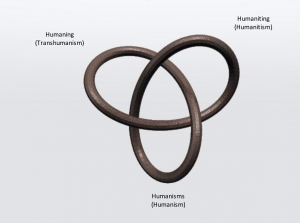
Source: Varey (2019)
Using (Charles Sanders) Peirce’s trichotomies as a premise, if we begin in firstness we might see the addition of technology to human desires as not ‘transhuman’, but rather ‘humaning’. The artifacts of the extension of human action – are ‘human’, in essence!
In a secondness, we might see the desire for a notably human expression in sensitivity as our distinctive ‘humanisms’. Like mannerisms, they cannot be mistaken as other than from the personality that originated them. We know us ~ when we see us, in expression!
In a co-joining of thirdness, we might see the intentionality of all human endeavours as directly benefiting the continuity of humanity. This is a ‘humaniting’ of directions intentioned. The mind that knows what is sensible and moral – is one that sees (and hopes) how a humanity may continue, with intentionality!
To quote Apithoria #1503 ~ “Actualisation is a realization of the essence of expression intentioned.”
The proposition is that the generative description of our humanity-becoming occurs (in conjunction) when: by our ‘humaning’, we find our ‘humanisms’, from within our ‘humaniting’.
As historical patterns of societal change show, from a thought, comes a concept, which in becoming a definition, forms a conception. Once held in reliance, we can return to this reliably.
Just perhaps the holding of a new humanitism, might entice a humanity into a novel direction.
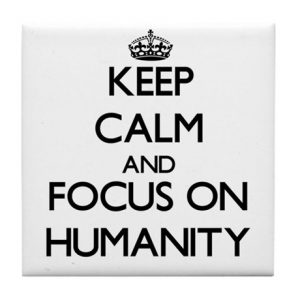
© willvarey (2019)

